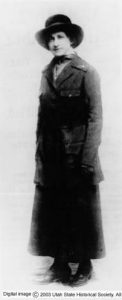Miriam B. Murphy
History Blazer, September 1995

Mabel Bettilyon was an Army nurse during World War I.
A remarkable group of women left Utah in uniform during World War I. They were registered nurses who enlisted in the Army or Navy Nurse Corps and staffed medical facilities located primarily in France and on military bases in the United States. An estimated 80 RNs—perhaps one-fourth or more of all the RNs in the state—answered the repeated call of the American Red Cross for nurses.
The Red Cross supplied the military with nursing personnel for its hospitals in the U.S. as well as field, evacuation, and convalescent hospitals in Europe. Some nurses drew the dangerous assignment of staffing mobile medical units, or dressing stations as they were often called, just behind the battle lines. By the time the U.S. entered the war in April 1917 the Red Cross had already established 25 base hospitals for the Army, with four more nearing completion, three for the Navy, and three field units. Since the War Department hoped to enlist 25,000 nurses by the end of 1917, the Red Cross began an intense recruiting campaign nationwide. Nurses wanting to enlist had to meet Red Cross standards and have “at least two years’ training in a hospital that averaged fifty patients a day of both sexes,” be registered to practice in their home states, provide evidence of good health, and be between ages 25 and 40.
Firsthand accounts of the experiences of these women are hard to find, but a letter and other memorabilia of Mabel Winnie Bettilyon of Salt Lake City open a window on a dramatic scene in wartime France. She was “attached to Evacuation Hospital No. 1. In one night alone more than 800 wounded American soldiers were brought into this hospital, 136 of whom were assigned to her care for want of sufficient nurses.” When the wounded arrived they had already had “first aid some place in the front lines.” In the receiving ward the patients were “undressed and all their personal belongings such as money, letters, pictures…put in a Red Cross bag,” she told her mother, Mary C. Bettilyon, adding, “so if you have made any [bags] you can see how your little bit helps.” Mabel praised the courage of her wounded countrymen, many of whom did not want to be sent home “‘until we get the Kaiser.'” Since this was an evacuation hospital, she cared for many German wounded as well but was glad when they left. “So many people are anxious for German souvenirs,” she wrote, “but…seeing our men wounded and dying is all I want that refers to Germany. I feel now as tho I wouldn’t give the smallest place in my trunk for anything off a prisoner.” Mabel served 14 months overseas.
Another nurse, Ruth Clayton, viewed her service in France as “the most important experience of her life because she was able to help.” A 1915 graduate of St. Mark’s Hospital School of Nursing, she joined the Army Nurse Corps in 1916 and may have served on the Texas border before going overseas. In France, working in a crowded hospital tent as part of a surgical team, she also saw some of the worst gas cases—men with swollen, disfigured faces, some blinded. Doctors quickly decided which of the wounded had the best chance to survive and channeled their own and the nurses’ efforts toward them. Facilities were primitive. Sometimes the only place to sit in the mess tent was on a wooden coffin. Clayton “couldn’t take hospital work” after the war and went into public health nursing. Her patriotism never waned, however, and during World War II she volunteered as a nurse at Bushnell Hospital, a military facility in Brigham City.
A number of Utah nursing leaders served in the war, including Ella M. Wicklund, a member of the first State Board of Nurse Examiners and secretary of the Red Cross in Salt Lake City before leaving for France early in 1918; Anna J. Hall, who is credited with raising the standards of nurses’ training at Ogden’s Dee Hospital; and Rose Karous, who introduced the visiting nurse concept locally and chaired Utah’s Red Cross Nursing Service for four years before she and her sister Frae joined the Navy Nurse Corps. Other significant nursing leaders who went to war were Anna Rosenkilde, superintendent of Primary Children’s Hospital from 1922 until her retirement in the mid-1940s; Carrie Roberts, one of the state’s first public health nurses; and Agnes M. Hogan, a founder of the Utah State Nurses Association.
More than 270 American nurses lost their lives during the war. Many died from pneumonia or from the deadly influenza epidemic. It does not appear that any of the fatalities were Utahns, although at least two nurses—Louise Owen, a member of the Disabled American Veterans, and Ella H. Conover—suffered impaired health as a result of their service.
At least two Utah nurses received special recognition for their service. Luella Francey, a 1907 graduate of St. Mark’s, was sent with a medical unit “to help the American Red Cross in its relief work in the Balkans,” for which she received the Serbian Cross of Mercy. Nancy V. Self, a prominent figure in nursing and health organizations in Ogden, served as a nurse with the American Expeditionary Forces in Europe and was “commended by the chief of staff of the host forces for her work in the field hospitals.”
For serving their country in wartime these nurses expected no acclaim. They knew they were following in the footsteps of those unsung heroines who nursed the wounded and dying during the American Revolution, the Civil War, and other lesser conflicts.
See Miriam B. Murphy, “‘If Only I Shall Have the Right Stuff’: Utah Women in World War I,” Utah Historical Quarterly 58 (1990).
